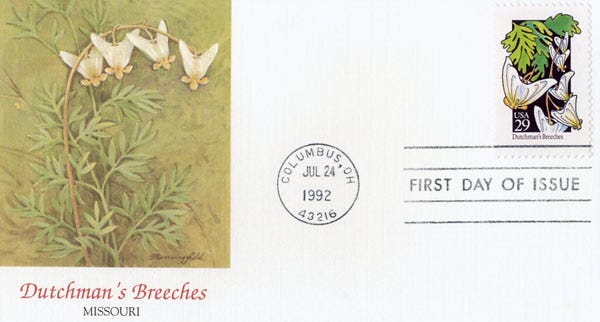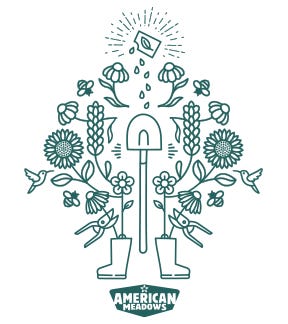Part Of The American Meadows Meadowscaping Learning Center
Missouri Native Plants, State Flowers & State Bird
Native plants are adaptable, low-maintenance, and beautiful. They are the best choice for habitat-friendly gardens and thriving ecosystems. Find top picks for native plants in your state - and learn about your state bird and state flowers!
Follow Along With More Of Our Guides
Hello native plant enthusiasts! In the list below, you will find popular native plants and wildflower seeds, available from American Meadows, that have a native distribution in your state. You’ll also find information about your state bird, state flower, and state wildflower!
About Our Native Plant Lists For Each State
- The links will take you to a single plant or seed selection for the plant listed -- but in many cases, we offer multiple cultivars for each plant, and we may offer both seeds and potted plants to grow the plant on your list. This list is a work in progress as we expand our native plant educational resources.
- The list for your state is a great place for getting started with native plants - but it is by no means a comprehensive listing of the hundreds of native plants growing in each state.
Missouri Native Plants
Grow our Native Midwest Wildflower Seed Mix
Virginia Bluebells (Mertensia virginica)
Showy Goldenrod (Solidago speciosa)
Wrinkleleaf Goldenrod (Solidago rugosa)
Black Eyed Susan (Rudbeckia fulgida)
Black Eyed Susan or Gloriosa Daisy (Rudbeckia hirta)
Purple Coneflower (Echinacea purpurea)
Pale Purple Coneflower (Echinacea pallida)
Yellow Prairie Coneflower (Ratibida columnifera)
Gray Headed Coneflower (Ratibida pinnata)
Butterfly Weed (Asclepias tuberosa)
Swamp Milkweed (Asclepias incarnata)
Common Milkweed (Asclepias syriaca)
Long Beaked Sedge (Carex sprengelii)
White Tinged Sedge (Carex albicans)
Wild Strawberry (Fragaria virginiana)
Plains Coreopsis (Coreopsis tinctoria)
Lanceleaf Coreopsis (Coreopsis lanceolata)
Wild Bergamot (Monarda fistulosa)
Wild Geranium (Geranium maculatum)
Elderberry (Sambucus canadensis)
Phlox divaricata (Woodland Phlox)
Obedient Plant (Physostegia virginiana)
Red Cardinal Flower (Lobelia cardinalis)
Blazing Star (Liatris spicata)
Prairie Blazing Star (Liatris pycnostachya)
Meadow Anemone (Anemone canadensis)
Bottlebrush Grass (Elymus hystrix)
Muhly Grass (Muhlenbergia capillaris)
Big Bluestem (Andropogon gerardii)
Muhly Grass (Muhlenbergia capillaris)
Little Bluestem (Schizachyrium scoparium)
Northern Sea Oats (Chasmanthium latifolium)
Yellow Prairie Grass (Sorghastrum nutans)
Smooth Blue Aster (Symphyotrichum laeve)
Aromatic Aster (Symphyotrichum oblongifolium)
New England Aster (Symphyotrichum novae-angliae)
Sky Blue Aster (Symphyotrichum oolentangiense)
Ironweed (Vernonia fasciculata)
Common White Yarrow (Achillea millefolium)
Heliopsis (Heliopsis helianthoides)
Purple Prairie Clover (Dalea purpurea)
Missouri State Bird, State Flower & State Wildflower

Eastern Bluebird ~ Sialia sialis
Gentle in manner and brilliantly colored, the Eastern Bluebird delights all who see it. The Bluebird "is like a speck of clear blue sky at the end of a storm," said Henry Thoreau. The settlers of the Plymouth colony noted the rusty breast of the Eastern Bluebird and called it the "blue robin." Like the robin, the Bluebird avoids the deep forest. He prefers the open country, roadside trees, orchards, and woodlands with plenty of tree hollows for nesting.
Red Hawthorn ~ Crataegus mollis
The Red Hawthorn is a handsome tree that in spring bursts into masses of white or pinkish blossoms. The tree, which grows to a height of thirty feet, is distinguished for its bright red edible fruit, often used for jelly and preserves. Its leaves have irregularly pointed margins and undersides covered with heavy down. Its thick foliage makes the Red Hawthorn a safe, sheltered place for the cardinals and brown thrashers who particularly like to nest in it. The Red Hawthorn's botanical name is taken from a Greek word meaning strength, and it refers to the extreme toughness of the wood.
From The Wildflowers of the 50 States U.S. stamps issued July 24, 1992:

About Native Plants
- Native plants are essential for healthy ecosystems and habitat. They have evolved over time with local wildlife and climate conditions. Many pollinators have special relationships with native plants that they rely on for survival. For instance, some bees are specialists and require nectar and pollen from specific native plants to survive; and butterflies and moths often have specific host plants needed to nourish their caterpillars. For example, Asclepias (Milkweed or Butterfly Weed) is the host plant required for Monarch caterpillars to survive and grow into Monarch Butterflies!
- It’s OK to grow native plants in your yard that may not be native to your state or region. Remember – just because a plant is not native, does not necessarily mean that it is invasive or harmful. In fact, growing well-behaved introduced plants that are suited to your growing conditions can still provide many benefits to your yard (especially when compared to a traditional turf lawn).
- Know before you grow – It's always a good idea to learn what plants are native, well-behaved, and invasive or aggressive in your region before digging in.
- Learn More: All About Native Plants
Explore our full selection of native plants and seeds
More From Our Learning Center

